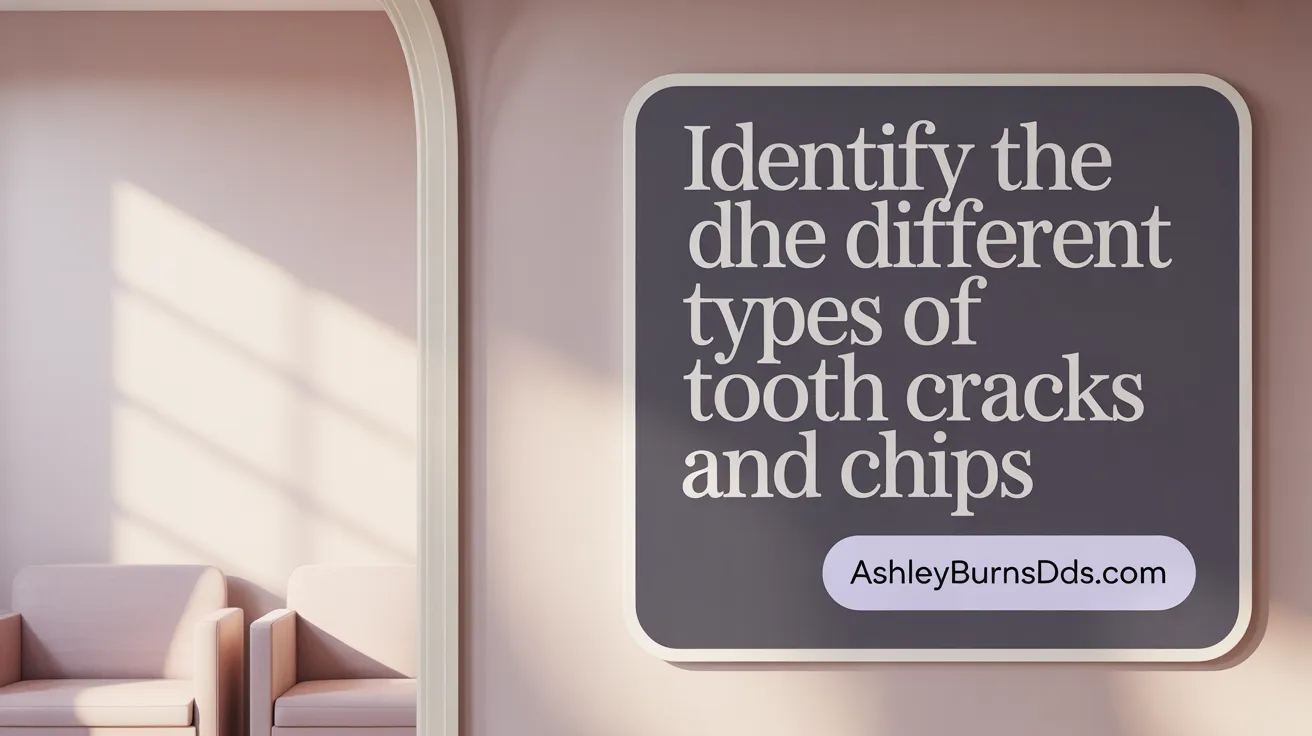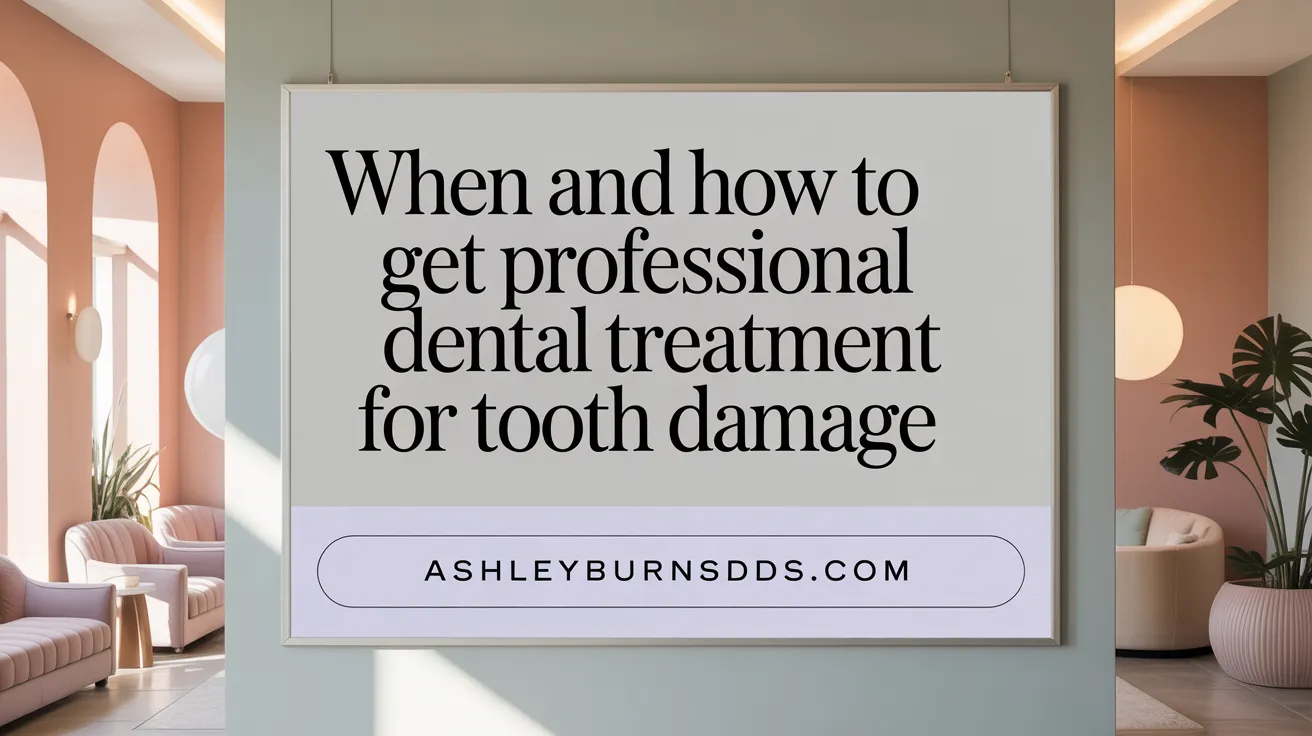Understanding Your Dental Injury
Cracking or chipping a tooth is a common dental issue that can happen to anyone. Whether caused by trauma, biting hard objects, or routine wear and tear, these injuries can vary in severity and symptomatology. Recognizing the signs early and knowing how to respond is crucial for preserving your tooth and preventing further complications. This guide offers comprehensive information on identifying, caring for, and treating cracked or chipped teeth, empowering you to take prompt, effective action.
Recognizing Causes, Symptoms, and Types of Cracked or Chipped Teeth
 Cracked or chipped teeth can occur for several reasons, often related to trauma, habits, or dental health conditions. Common causes include injuries from falls, sports accidents, or blows to the face, as well as biting or chewing on hard objects like ice, candy, or nuts. Dental decay or large fillings can weaken the enamel, making teeth more susceptible to cracking or chipping. Teeth grinding (bruxism) and age-related wear also increase vulnerability, particularly as enamel becomes thinner over time (Causes of a chipped tooth, Cracked tooth causes).
Cracked or chipped teeth can occur for several reasons, often related to trauma, habits, or dental health conditions. Common causes include injuries from falls, sports accidents, or blows to the face, as well as biting or chewing on hard objects like ice, candy, or nuts. Dental decay or large fillings can weaken the enamel, making teeth more susceptible to cracking or chipping. Teeth grinding (bruxism) and age-related wear also increase vulnerability, particularly as enamel becomes thinner over time (Causes of a chipped tooth, Cracked tooth causes).
Symptoms to watch for include pain or discomfort when chewing or biting, especially if the pain is sharp or intermittent. Sensitivity to hot, cold, or sweet foods is common, as cracks expose the inner, sensitive tissues of the tooth. Visible signs of damage may include small chips, rough edges, or a distinct line indicating a crack. Swelling or inflammation around the affected area can occur, especially if bacteria enter through the crack, leading to infection (Symptoms of a chipped tooth, Symptoms of cracked tooth.
Different types of cracks and chips vary in severity and appearance. Craze lines are tiny, hairline cracks confined to the enamel, often painless and primarily cosmetic. Fractured cusps involve a break around a chewing surface, which may cause discomfort. A split tooth carries a crack that extends deep enough to split the tooth into parts. Vertical root fractures start below the gum line and can be difficult to detect but may cause persistent pain and gum swelling. Minor chips mostly affect the appearance and can be easily repaired, whereas severe cracks may require crowns, root canals, or even extraction (Types of cracked teeth, Minor vs Severe Tooth Chips).
Risk factors such as aging, previous dental treatments, poor oral hygiene, and conditions like GERD contribute to the likelihood of developing cracks or chips. Over time, acidic foods, dental erosion, and weakened enamel increase the risk. Early diagnosis and treatment by a dentist are vital to prevent more serious complications, including infections, worsening fractures, or tooth loss (Risk Factors for Cracked and Chipped Teeth, Preventing chipped teeth.
Identifying Signs and Symptoms of Cracked or Chipped Teeth
How can one recognize the signs and symptoms indicating a cracked or chipped tooth?
Recognizing a cracked or chipped tooth involves paying attention to several noticeable signs. Common indicators include sharp pain when biting or chewing, which may come and go, and heightened sensitivity to hot, cold, or sugary foods. Swelling or tenderness in the gums near the affected tooth can also signal underlying damage. Visually, you might notice a crack running across the tooth, a missing piece, or a rough, jagged edge. Sometimes, a crack may be too small to see without a dental examination.
In addition to visible and tactile signs, symptoms can include intermittent or persistent toothache, particularly if the crack has exposed the nerve inside the tooth. This pain may intensify during biting or when the tooth contacts certain foods. Interestingly, some cracks are initially asymptomatic, especially small or hairline cracks, making early detection challenging. People who grind their teeth or bite on hard objects are at higher risk.
If any of these signs are present, seeing a dentist promptly is crucial. Proper diagnosis often involves visual inspection and imaging tests like X-rays to determine the extent of the damage. Early treatment can prevent further deterioration and save the tooth from potential infection or loss. For more details about signs of a cracked tooth and symptoms of cracked tooth, as well as understanding symptoms of a chipped tooth, check the provided resources.
Immediate Actions and At-Home Care for Cracked or Chipped Teeth
In the event of a tooth crack or chip, the first step is to gently rinse the mouth with warm water to clean the area and remove any debris. If there are broken fragments, these should be carefully preserved by placing them in a container of milk, saline solution, or saliva, as this increases the chances they can be reattached by the dentist (Knocked-out tooth emergency, Saving broken tooth pieces).
Controlling bleeding is essential; apply gentle pressure with sterile gauze or a damp tea bag to stop any bleeding and reduce discomfort (How to stop tooth bleeding, Using gauze for oral bleeding). To manage pain and swelling, over-the-counter pain relievers such as acetaminophen or ibuprofen can be taken, along with applying a cold compress or ice pack wrapped in a cloth to the affected area for 15-20 minutes (Pain relief for chipped tooth, Applying ice for tooth pain).
To prevent further damage or injury, avoid chewing on the affected side and stick to soft foods to reduce strain on the damaged tooth. Protect sharp or rough edges with dental wax, sugar-free chewing gum, or temporary dental cement, which can be purchased at pharmacies, to shield your tongue and cheeks from injury (Protective measures for chipped teeth, Dental wax for cracked tooth).
These initial measures are critical for minimizing pain, preventing infection, and protecting the tooth until professional dental treatment is obtained. Prompt visit to a dentist is necessary for a thorough evaluation, which may include bonding, veneers, crowns, or other restorative procedures depending on the injury’s severity (Dental treatment for chipped teeth, Dental bonding for chipped teeth, Root canal for chipped tooth). Acting quickly enhances the chances of preserving the natural tooth and avoiding more complicated treatments (Emergency dental care for tooth injuries, When to see a dentist for chipped tooth).
Distinguishing Dental Emergencies from Non-Urgent Tooth Fractures
How can one differentiate between a dental emergency and a non-urgent case related to tooth fractures?
Deciding whether a tooth fracture is an emergency or not largely depends on the severity and symptoms involved.
Dental emergencies often display signs such as intense pain that persists despite pain relievers, bleeding that cannot be controlled, a loose or completely knocked-out tooth, or visible deep cracks that expose the nerve tissue inside the tooth. These situations require immediate professional attention to prevent infection, further damage, or even tooth loss (broken tooth dental emergency, Cracked tooth dental emergency, Dental emergency guidance).
In contrast, non-urgent cases typically involve minor chips or cracks that do not cause pain, swelling, or bleeding. For instance, small enamel chips or superficial craze lines normally do not threaten the health of the tooth and can be scheduled for treatment at a later time (Signs of a cracked tooth, Chipped Tooth Causes and Symptoms, Cracked tooth overview.
Basic first aid for both cases
If you encounter a tooth injury, there are simple steps to take while waiting for professional care. For emergencies, gently rinse the mouth with warm water, apply a cold compress to reduce swelling, and try to control bleeding with gentle pressure using sterile gauze. If a tooth has been knocked out, store it in milk or saline and seek urgent dental help within an hour (Knocked-out tooth emergency care, Handling knocked-out teeth safely, First aid for tooth injury.
For minor chips or cracks, rinse the mouth, avoid chewing on the damaged side, and use over-the-counter pain medication if necessary. Cover sharp edges with dental wax or sugarless gum to prevent injury to soft tissue (Chipped tooth care tips, Using dental wax for cracked tooth, Self-care for chipped teeth.
While minor injuries can wait for scheduled dental visits, any signs of severe pain, bleeding, or visible nerve exposure should prompt immediate action. Prompt care helps preserve the tooth and prevent complications like infection or additional damage (Chipped Tooth Treatment, Cracked Tooth Treatment Options, Managing cracked tooth pain.
Professional Dental Treatments: When and How to Seek Care

When and how should professional dental treatment for cracked or chipped teeth be sought?
Seeking prompt dental care for cracked or chipped teeth is essential to prevent further damage and complications. You should see a dentist immediately if you experience severe pain, bleeding, swelling, or if a significant fragment of the tooth is missing. In such cases, rinsing the mouth with warm water to clean the area, applying a cold compress to reduce swelling, and saving any broken pieces in a moist environment like milk or saline can improve chances of reattachment (first aid for chipped tooth, knocked-out tooth emergency, broken tooth dental emergency).
Even if the damage appears minor, scheduling a dental evaluation promptly is advised. Dentists use visual inspection, X-rays, and advanced diagnostic tools like dye tests and transillumination to assess the severity of the crack or chip (diagnosis of cracked tooth, diagnosing cracked teeth). The treatment plan varies from simple procedures such as bonding or polishing for minor issues, to placing crowns or veneers for larger damage, and root canal treatments if the pulp is exposed (dental procedures for chipped teeth, root canal therapy for cracked teeth, crowns for cracked teeth.
Timely treatment not only restores the appearance and function of the tooth but also significantly reduces the risk of infection and long-term damage (treatment options for cracked tooth, risks of untreated chipped tooth). Until professional help is obtained, avoid biting on hard foods, using your teeth as tools, or consuming extremely hot or cold foods, which can exacerbate the problem (preventing damage from chipped teeth, avoiding hard or sticky foods with cracked tooth. Quick action and proper dental care are vital to preserving your tooth and maintaining oral health (dental care for broken teeth, emergency dental care for tooth injuries.
For further information, search using the query "professional dental treatment cracked chipped tooth" to find reputable resources and dental treatment guidelines.
Preventive Measures and Cost Considerations for Tooth Fractures

What preventive measures can help reduce the risk of cracking or chipping teeth?
Preventive strategies are crucial in avoiding tooth fractures. One of the most effective methods is wearing mouthguards during sports and physical activities, which provides a protective barrier against trauma and impacts. Avoiding the use of teeth to open packages or biting down on hard objects like ice, pens, or sticky candies can prevent undue stress that leads to chips. Maintaining good oral hygiene through regular brushing, flossing, and dental check-ups helps detect and treat decay early, reducing the risk of weakening tooth structure. Managing conditions such as teeth grinding (bruxism) with custom night guards and stress management can also prevent fractures caused by consistent pressure. Diet choices matter too—limiting sugary and acidic foods can strengthen enamel and prevent erosion. Protecting weakened teeth by avoiding hard or brittle foods and seeking prompt dental care for small cracks or wear can significantly reduce the chance of severe fractures.
What costs and factors should be considered when treating cracked or chipped teeth?
Treatment costs for cracked or chipped teeth can vary widely based on the extent of damage and the chosen procedure. For minor chips, procedures like dental bonding or smoothing might cost between $100 and $500. More extensive repairs, such as crowns or veneers, typically range from $800 to $3,000 per tooth, depending on materials and dental practice location. Surgical options like root canals or implants can go beyond $1,000 to $5,000. Several factors influence costs, including geographic location, the complexity of the case, the materials used, and whether sedation or specialized care is needed. Additionally, the patient's dental insurance may cover part of the treatment, reducing out-of-pocket expenses. It’s important to discuss all costs beforehand and consider the long-term benefits of investing in durable solutions that prevent further damage and preserve oral health.
| Treatment Type | Cost Range | Additional Details |
|---|---|---|
| Dental bonding | $100 - $500 | Suitable for minor chips; quick procedure |
| Crowns or veneers | $800 - $3,000 | For larger damage; provides strength and aesthetics |
| Root canal and crown | $1,000 - $3,500 | For deep cracks involving pulp exposure |
| Tooth extraction & implant | $1,500 - $5,000 | For severely damaged or non-restorable teeth |
| Cosmetic treatments | Varies | Higher costs for veneers or aesthetic crowns |
Being aware of these factors helps patients budget appropriately and make informed decisions. Early intervention often reduces the overall expense and long-term health risks.
Taking Action to Protect Your Smile
Cracked or chipped teeth should never be ignored. Prompt recognition of symptoms, immediate self-care, and quick access to professional dental treatment are key to preserving your tooth and preventing pain or infection. By understanding the causes and risks, practicing preventive habits like wearing mouthguards, and seeking timely care, you can protect your oral health and maintain a confident smile for years to come. Remember, when it comes to tooth fractures, early intervention is the best defense against more serious dental issues.
